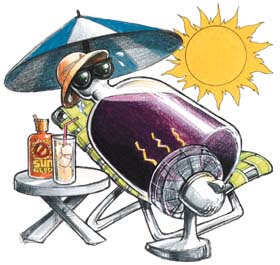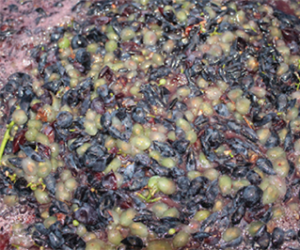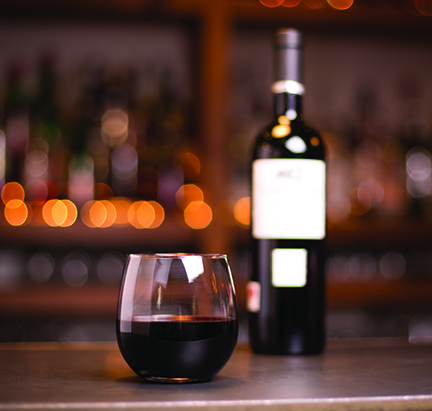
It was early August 1988. My mother lived near Temecula, California on a property with 100 Cabernet Sauvignon vines. My husband and I were bringing the small vineyard back to life after two years of neglect. The grapes were ripening very nicely, but unfortunately, I was ripening a little faster. I was nine months pregnant and due August 8. If I waited until after I delivered, the grapes would be too ripe, so we picked the grapes before they were ready.
The temperature hit 100° F that day. We picked early in the morning and then went to my obstetrician appointment in the afternoon. My husband destemmed the grapes by hand in the back of my brother’s pickup in the doctor’s parking lot. He had plenty of time; expectant mothers have been known to go through entire trimesters in obstetrician waiting rooms.
We crushed the grapes that night, with our feet, of course. I was literally “barefoot and pregnant.” We had one air-conditioned room, so that’s where we placed the fermenter, a large plastic garbage can. After a few days, we transferred the juice off the skins into glass carboys. We used the simple evaporative cooling method (see below) to keep the temperature in check. I was very pleased with the wine several months later. So the moral of the story is: If you think it’s too hot to make wine, try giving birth.
The reality is that grapes are a hot-weather crop in many wine regions worldwide. In Texas, harvest occurs around the first of August, when nighttime lows are rarely below 75° F and daytime highs reach 100° F. The southernmost winery in the United States, Eden Vineyards and Winery, makes wines in the tropical climate near Fort Myers, Florida. And last August I visited the Ferino wineries in Cuatro Cienegas, Mexico. The Ferino family has been growing grapes and making wine in the hot, arid and isolated Chihuahuan desert for over a century. Real wineries deal with real heat and make wonderful wines. It isn’t all that difficult. Here are some suggestions.
Ferment at High Temps
Ed and Madeleine Manigold of Spicewood Vineyards, a small winery in the Texas Hill Country, ferment red wines at 85-90° F. (Commercial wineries ferment reds as low as 75° and as high as 95° F.) Higher temperatures are believed to extract more color from the skins and lend more intense flavors to the wine.
The good news for home winemakers is that these temperatures are not very different from the temperature in many homes during the hot summer months. For many people, fermenting reds simply means moving the fermenter to a closet or corner of your home where the temperature doesn’t fluctuate much. A basement or cellar is often a very good choice, although basements are unusual in some regions of the U.S. You should avoid placing a fermenter in direct sunlight, from a window, for example. Direct sun can cause significant temperature fluctuations, making the wine hot in the day and much cooler at night. Covering your fermenter — with a bag, for example — will keep out the visible light but will not stop the undesired heating from the sun.
Stick with Small Fermenters
Commercial wineries use large fermenters, often 1,000 gallons and larger, which present a distinct disadvantage. According to Manigold, reds would reach fermentation temperatures as high as 110° F at Spicewood Vineyards if left unchecked, while a small home winemaker’s fermenter would not exceed 95° F under the same conditions. Why? Because the chemistry of fermentation generates its own heat. In a large fermenter this can increase the temperature of the must well above the ambient temperature. Small fermenters have a much greater ratio of surface area to volume, which means heat is more efficiently released through the walls of the fermenter.
If you are fermenting whites, typically fermented over the 55-70° F range, or if your home temperature routinely exceeds 85-90° F during the summer, then you have a few options to bring the temperature down.
The Wet T-Shirt Trick
The accompanying article in this issue nicely describes the evaporative cooling method. Simply place your carboy in a tray of water and drape it with a wet T-shirt. The T-shirt pulls the water up like a wick and evaporation cools the fermenter. The lowest temperature you can reach with this method is the “dewpoint temperature,” the temperature at which water condenses. The dewpoint depends on the amount of moisture in the air. The less moisture, the lower the dewpoint. In arid regions, such as the desert Southwest, the dewpoint is much lower than the ambient temperature, so this is a very effective cooling technique. By way of example, at 95° F and 15% relative humidity (in an arid region), the dewpoint is 39° F. At 95° F and 80% relative humidity (conditions you’d find in the Mississippi River Valley), the dewpoint is 88° F.
Evaporative cooling is less effective in humid areas. However, even in those areas, the humidity in homes is usually less than the humidity outside, so evaporative cooling can still be sufficiently effective. If you live in a humid area, you might use a dehumidifier to bring down the humidity and dewpoint, and thus increase the effectiveness of evaporative cooling.
The Spare Fridge
Another failsafe method of cooling is to employ a refrigerator or freezer. Thermostats on refrigerators and freezers are adjustable over temperature ranges that are too cold for wines. Therefore it is necessary to invest in an external thermostat. A simple, reliable external temperature controller, available at most winemaking shops for $50-$60, will regulate the temperature from freezing up to 80° F. Drop-in freezers offer the most space for the best price. However, it does take considerable strength to lift a fermenter in and out of a drop-in freezer.
Ice and More Ice
Ice can also be used to cool fermentations. Some winemakers place blocks of ice, in plastic bags, directly into the fermenting juice. But plastic bags can break at the seams and leak the melting ice into your fermenter. A better solution is to use food-grade plastic jugs (orange juice, for example). They are durable, easy to use, and reusable. You should stir the must a few times each day to keep the temperature uniform. Otherwise, the ice creates pockets of very cold juice that will impede the yeast.
Another method is to immerse the fermenter into a water bath (for example, place the fermenter into a large garbage can and fill with water) and add ice blocks to the water bath. This method has the advantage of less temperature fluctuation because the water bath, along with the fermenting juice, buffers against large temperature changes. On the other hand, the direct method gives the greatest amount of cooling for a given amount of ice.
Heat Exchangers
Another method of cooling is based on the “drapeau” method used in France, and now quite extensively in commercial wineries, to increase the fermentation temperature. The French pass warm water through a stainless-steel heat exchanger immersed in the fermenting must. Home winemakers can pass cool water through a stainless coil immersed in the must. This is analagous to the “wort chillers” employed in homebrewing. (Wort chillers are often made of copper, but you should never immerse copper in wine. Copper will spoil wine.)
You can easily regulate the fermentation temperature according to your water temperature. Tap water in our area typically varies from 75-80° F during the hottest months. Well water is usually lower. This method requires a fermenter with a large opening, like a plastic pail or stainless steel tank, in order to submerge the stainless steel coil. Though effective, this method has some distinct disadvantages for most home winemakers. First, stainless-steel coils are not widely available and, unlike soft copper, stainless-steel tubing is difficult to coil. Another drawback is significant water usage.
Bulk Aging
After fermentation, wines are usually bulk aged in stainless-steel tanks, glass carboys or oak barrels for up to several months. Ideally, you would like to keep the temperature around 55-60° F for most reds and whites. Again, one might use a wet T-shirt or an externally regulated freezer. Either method may be impractical, due to the time commitment or the volume of wine. This is one area where I accept that my home temperature is good enough.
Bottled wines are ideally stored at 60-65° F. This is another area where I simply accept a dark closet in the coolest area of my home. Wild temperature fluctuations are probably more detrimental to the wine than exceeding this range by even 10 or 15 degrees.
The type of fermenter or aging tank influences the type of cooling method employed. Each has its merits. Food-grade plastic pails are often used for primary fermentation, particularly for reds, because you need skin contact. Glass carboys are impractical because it is difficult to funnel grape skins through the narrow neck.
Plastic is a good heat insulator, which makes it a poor choice for evaporative cooling. On the other hand, since it is a good insulator, it buffers against temperature fluctuations between day and night. Similarly, oak barrels are good insulators, so evaporative cooling is difficult. Oak chips offer an alternative while aging in plastic, glass or steel.
Stainless-steel tanks are good heat conductors and are good choices for employing evaporative cooling. Like plastic pails, they can be used for fermenting reds with the skins. The “variable capacity” tanks with pneumatically sealed lids can be used for bulk storage as well. They are considerably more expensive than carboys or pails.
Glass carboys are commonly employed for aging and fermentations without the skins because they are moderately good conductors and the tapered neck permits easy “topping off” so the maturing wine is not exposed to air.
By the way, my son was a “late harvest.” He arrived more than two weeks after his due date. Clearly, we need a better baby refractometer. That said, hot weather is a challenge that is easily handled, even in the most extreme conditions. So when the heat rises, don’t sweat it.






